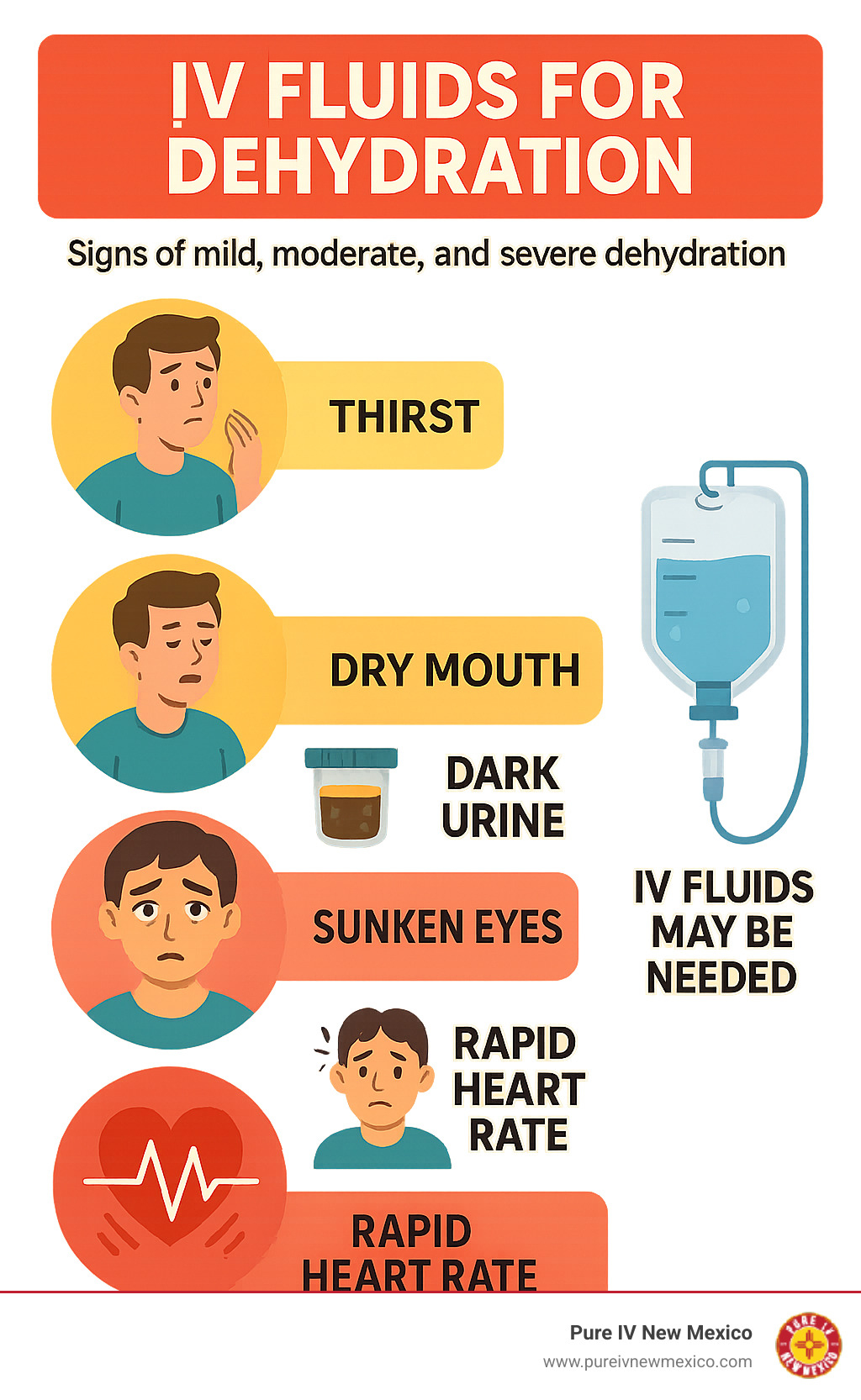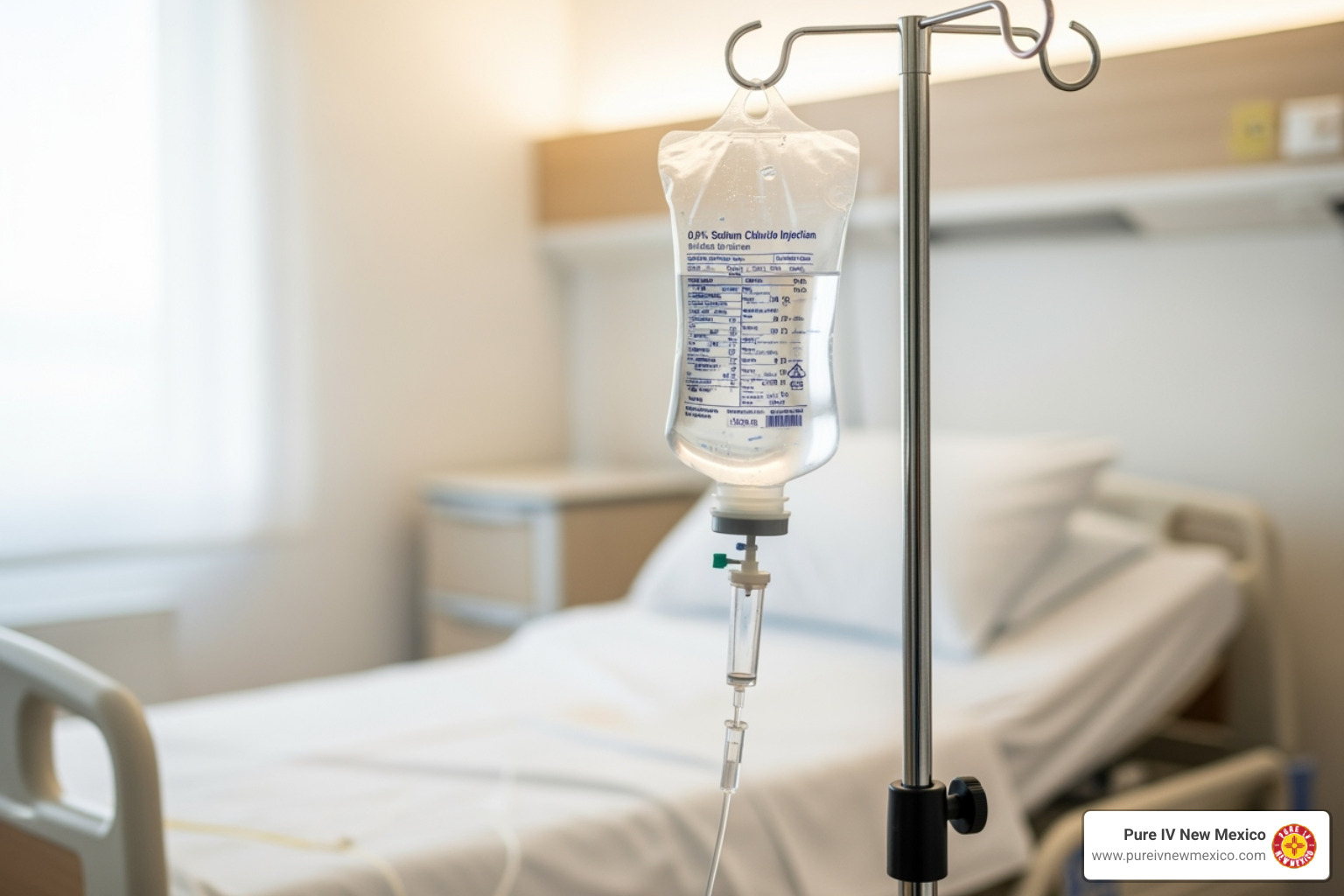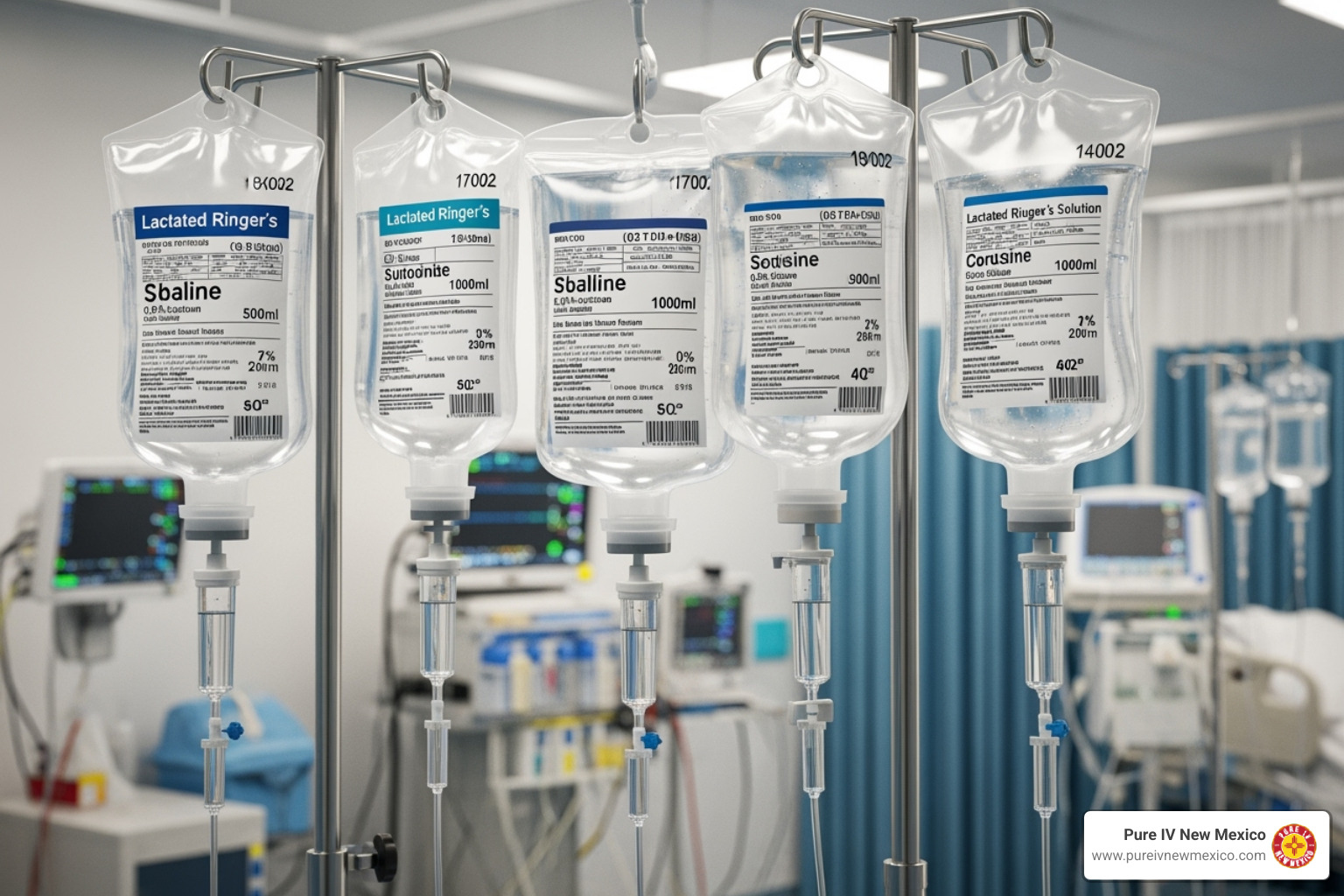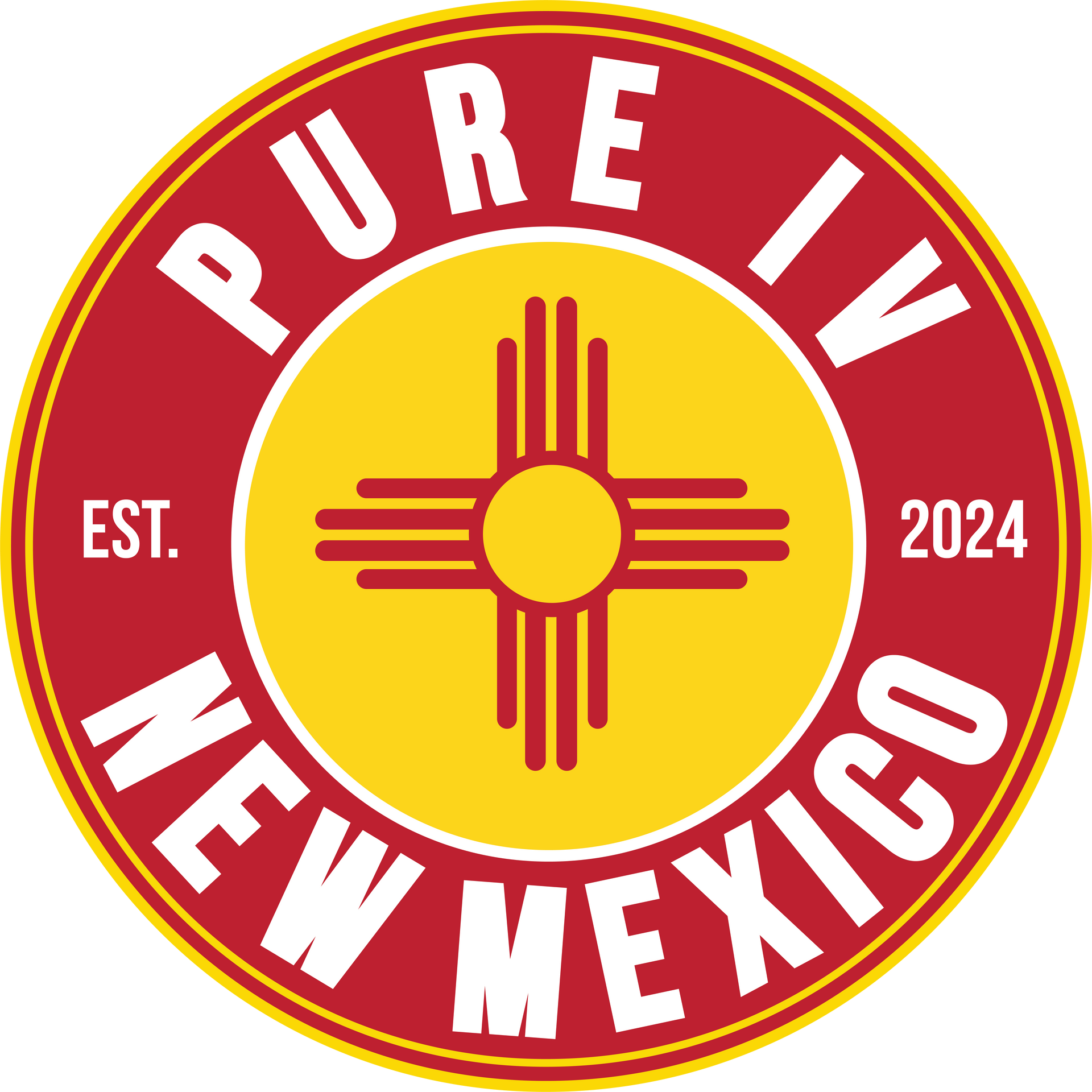The Ultimate Guide to IV Fluids for Quick Rehydration

Medically reviewed by Micaela Strevay, FNP-C, PMHNP-BC
Table of Contents
The Role of IV Fluids for Dehydration

IV fluids for dehydration are a critical medical tool for rapid fluid replacement. Intravenous treatments are necessary for:
- Severe Dehydration : Marked by extreme thirst, confusion, dizziness, or fainting.
- Inability to Drink : Due to persistent vomiting, diarrhea, or unconsciousness.
- Rapid Onset Symptoms : In cases like heat stroke or shock where immediate fluid is vital.
- Pediatric Concerns : Severe signs in children include irritability, sunken eyes, or no wet diapers for hours.
Dehydration occurs when fluid loss outpaces intake. Since our bodies are about 60% water, even minor fluid loss can affect physical and mental function. While drinking water is the standard solution, it can take up to an hour for the body to orally process a liter of water. IV fluids offer a faster alternative by bypassing the digestive system, delivering hydration and nutrients directly into the bloodstream for immediate relief.
At Pure IV New Mexico, we specialize in delivering personalized and accessible iv fluids for dehydration , ensuring safe and effective care. This guide will walk you through everything you need to know.

Iv fluids for dehydration glossary:
Understanding Dehydration: From Thirst to Medical Emergency
Dehydration is more than just thirst; it's a state where your body lacks sufficient water to function correctly. Since the importance of water for the human body is so high—we're about 60% water—even small fluid losses can impact everything from temperature regulation to nutrient transport. The most common causes are vomiting and diarrhea , which rapidly deplete fluids and electrolytes. Other major contributors include excessive sweating from exercise or heat, fever , and simply insufficient fluid intake . Certain medical conditions, like uncontrolled diabetes, can also lead to increased fluid loss.
Common and Severe Symptoms of Dehydration
Recognizing the signs of dehydration is key. Early warnings include thirst , dry mouth , fatigue , headache , and dark yellow urine . These are signals to increase your fluid intake immediately.
If ignored, symptoms can escalate to a medical emergency requiring IV fluids for dehydration . Severe signs include a rapid heartbeat , confusion , fainting , lack of urination , and sunken eyes . In children, watch for a lack of tears, no wet diapers for several hours, or a sunken soft spot on the head.
Prevention: Your First Line of Defense
Prevention is the best defense. Make hydration a daily habit, aiming for the recommended daily fluid intake, which includes water from all beverages and foods. According to guidelines on daily water intake , needs vary, but consistency is crucial.
During illness or heavy sweating, replenish electrolytes like sodium and potassium, which help your body retain fluid. Incorporating water-rich foods like watermelon and cucumbers also contributes to your hydration. Pay close attention to your fluid intake during hot weather, exercise, or illness.
When Are IV Fluids for Dehydration Medically Necessary?

IV fluids for dehydration become medically necessary when oral rehydration is not possible or sufficient. Healthcare providers recommend IV therapy in specific situations, such as persistent vomiting or severe diarrhea that prevent you from keeping fluids down. Other critical indicators include an altered mental state (confusion, dizziness, loss of consciousness), signs of shock (rapid heartbeat, low blood pressure), or a severe electrolyte imbalance . In these cases, IV fluids are essential to quickly restore fluid volume and correct mineral imbalances by bypassing the digestive system.
Identifying High-Risk Individuals
Certain groups are more vulnerable to severe dehydration. Infants and children are at high risk due to their smaller body size and faster metabolism; in fact, 80% of pediatric IV rehydration is due to gastrointestinal fluid loss. Older adults are also susceptible as their thirst sensation diminishes with age. Individuals with chronic illnesses like diabetes or kidney disease face challenges with fluid balance. Even healthy athletes can require IV fluids after intense exercise. Others at high risk include those with severe acute malnutrition, extensive burns, or significant bleeding.
Medical Indicators for IV Fluid Treatment
Specific medical conditions often necessitate iv fluids for dehydration . These include severe gastrointestinal fluid loss from gastroenteritis (stomach flu), where IV fluids support the body while it fights the infection. Heat-related illnesses like heat stroke and severe burns require aggressive fluid replacement to prevent organ damage. IV fluids are also standard pre- and post-surgery to maintain hydration and deliver medication. Other conditions requiring IV rehydration include hypercalcemia (high blood calcium) and severe diarrheal diseases like cholera , where rapid fluid replacement is life-saving. In these scenarios, as detailed in resources like StatPearls on Adult Dehydration , IV fluids are a critical medical intervention.
The Science Behind IV Rehydration: Types and Process

The science behind iv fluids for dehydration centers on osmolarity —the concentration of particles like salt and sugar in a solution. This property determines how the fluid interacts with your body's cells, moving water where it's needed most to restore balance. These are not simple tap water; they are sterile, precisely formulated solutions designed for safe intravenous delivery.
Types of IV Solutions and Their Purpose
The most common IV fluids are crystalloids , which are water and electrolyte solutions categorized by their osmolarity relative to your blood.
| Fluid Type | Osmolarity Relative to Plasma | Primary Effect | Common Examples | Primary Use for Dehydration |
|---|---|---|---|---|
| Isotonic | Similar (same solute concentration) | Stays in intravascular space, expands fluid volume | 0.9% Normal Saline, Lactated Ringer's, D5W (5% Dextrose in Water) | Most common for general dehydration, fluid resuscitation, shock. |
| Hypotonic | Lower (less solute concentration) | Moves fluid from intravascular space into cells | 0.45% Saline (Half Normal Saline) | Used for cellular dehydration (e.g., hypernatremia, diabetic ketoacidosis) to rehydrate cells. |
| Hypertonic | Higher (more solute concentration) | Moves fluid from cells into intravascular space | 3% Saline, D5NS, D5LR | Used in severe cases of hyponatremia (low sodium) or cerebral edema to draw fluid out of cells. |
- Isotonic fluids like 0.9% Normal Saline and Lactated Ringer's are the standard for most dehydration cases because their concentration matches your blood, rapidly increasing fluid volume in the blood vessels.
- Hypotonic fluids like 0.45% Saline have a lower concentration, which helps move water into dehydrated cells. They are used for conditions like hypernatremia.
- Hypertonic fluids are highly concentrated and pull water out of cells. They are reserved for critical situations like severe low sodium or brain swelling and require careful monitoring.
A healthcare provider chooses the correct fluid based on your specific level of dehydration, health conditions, and electrolyte levels to ensure the treatment is both safe and effective.
The Process of Receiving IV Fluids for Dehydration
Receiving iv fluids for dehydration is a straightforward procedure performed by a licensed professional. Here's a summary of the process:
- Assessment : A provider reviews your medical history and hydration status to create a personalized treatment plan.
- Vein Selection : A suitable vein, typically in the arm or hand, is located.
- Catheter Insertion : The site is cleaned, and a sterile needle is used to insert a small, flexible plastic tube (catheter) into the vein. The needle is then removed, leaving the soft catheter in place.
- Infusion : The catheter is secured and connected to the IV bag. The fluid drip rate is carefully controlled, either manually or with a pump.
- Monitoring : Throughout the infusion, which typically lasts 45-60 minutes for wellness treatments, a professional monitors the IV site and your response.
At Pure IV New Mexico, our licensed professionals are experts in this process, ensuring your comfort and safety whether in our clinics or through our mobile service.
Benefits, Risks, and the Rise of IV Therapy

When medically necessary, iv fluids for dehydration offer significant advantages over oral hydration.
Medical Benefits
- Rapid Absorption : Fluids enter the bloodstream directly, bypassing the digestive system for immediate effect. It can take an hour to orally absorb a liter of water, but an IV delivers fluids instantly.
- 100% Bioavailability : Unlike oral intake where nutrients can be lost during digestion, IV delivery ensures every drop reaches your cells for maximum effectiveness.
- Bypassing the Digestive System : This is crucial for patients with severe vomiting or diarrhea who cannot keep fluids down.
- Precise Dosage Control : Professionals can administer the exact amount of fluid and nutrients required, ensuring a safe and custom treatment.
Potential Risks and Complications of IV Therapy
While generally safe when administered by licensed professionals, IV therapy is a medical procedure with potential risks:
- Infection : Any break in the skin carries a small risk of infection at the injection site.
- Infiltration/Extravasation : Fluid may leak from the vein into surrounding tissue, causing swelling and pain. Extravasation is a more serious form where the fluid can damage tissue.
- Phlebitis : The vein can become inflamed, causing pain and redness. You can learn more about the related condition, thrombophlebitis.
- Fluid Overload : Administering fluids too quickly can strain the heart and kidneys, especially in individuals with pre-existing conditions.
- Electrolyte Imbalance : Incorrect fluid formulation can worsen or create new electrolyte imbalances.
- Allergic Reactions : Though rare, reactions to the fluid or catheter materials can occur.
These risks underscore the importance of having iv fluids for dehydration administered only by trained medical professionals who can manage treatment safely.
IV Therapy for Wellness and Performance
IV therapy has also become popular in wellness settings for non-critical issues:
- Hangover Relief : IV fluids can quickly alleviate hangover symptoms, but oral hydration is often sufficient and more affordable for mild cases.
- Athletic Performance : Athletes use IV drips for rapid recovery, though the risk-benefit profile for healthy individuals is debated.
- Beauty and Anti-Aging : Drips with vitamins and antioxidants are offered for cosmetic benefits, but scientific evidence for these claims is often limited.
- Jet Lag : While an IV can provide a hydration boost, its effectiveness for jet lag is largely anecdotal.
For most mild issues, oral rehydration is the safest and most cost-effective choice. An IV infusion is a medical procedure that can cost hundreds of dollars, whereas drinking fluids is nearly free. It's crucial to weigh the convenience against the cost and potential risks. At Pure IV New Mexico, our licensed professionals provide safe, individualized care, ensuring every treatment is appropriate for your specific needs and wellness goals.
Special Considerations and Clinical Insights
In medical settings, the use of iv fluids for dehydration is carefully considered. For mild to moderate cases, oral rehydration is the preferred method as it is safer and less invasive. However, IVs are sometimes overused; one study showed 70% of hospitalized children received IV fluids when not severely dehydrated . This highlights the importance of clinical guidelines, which help providers use IV therapy only when medically necessary and determine the correct fluid type and volume.
Specific Guidelines for IV Fluids for Dehydration in Children
Children are especially vulnerable to dehydration due to their smaller body size and inability to communicate their needs. Administering iv fluids for dehydration to children requires precise calculations based on weight. For a child in shock, a fluid bolus of 10-20 mL/kg of 0.9% sodium chloride may be given. IV hydration is common for pediatric illnesses; about half of infants hospitalized for the flu and nearly a third for bronchiolitis receive it.
The NICE guidelines for IV therapy in children stress using oral or nasogastric rehydration whenever possible. They also warn against using certain hypotonic fluids for routine maintenance due to the risk of hyponatremia (low sodium), which can be dangerous. For this reason, children with severe dehydration are often treated in an emergency department where IV fluids are a primary intervention.
At Pure IV New Mexico, our licensed professionals deliver all treatments with the utmost care and precision, following strict medical guidance, especially for younger clients.
Frequently Asked Questions about IV Rehydration
Here are answers to some common questions about iv fluids for dehydration .
How long does it take for IV fluids to rehydrate you?
IV therapy works quickly because fluids enter the bloodstream directly, bypassing the digestive system. Most people feel better within 30 to 60 minutes , which is the typical infusion time for a wellness treatment at Pure IV New Mexico. The total time to full rehydration depends on the initial level of dehydration, with severe cases sometimes requiring several hours of infusion.
Is getting an IV for dehydration painful?
Most people experience only minimal discomfort . There is a brief pinch when the needle is inserted, but it is immediately removed, leaving a soft, flexible plastic catheter. Once the catheter is in place, the infusion is typically painless. Our skilled nurses at Pure IV New Mexico are experts at making the process as gentle as possible.
Can you be dehydrated even if you drink a lot of water?
Yes , you can. True hydration requires a balance of both water and electrolytes like sodium and potassium. During intense sweating, vomiting, or diarrhea, you lose significant amounts of these crucial minerals. Drinking only plain water can further dilute your body's electrolyte levels, leading to a condition called hyponatremia. In these situations, iv fluids for dehydration are effective because they replenish both fluids and essential electrolytes simultaneously.
Conclusion
This guide has covered the full spectrum of iv fluids for dehydration , from simple prevention to critical medical intervention. We've seen that while IV fluids are a vital tool for severe cases—like persistent vomiting or heat exhaustion—providing immediate relief by bypassing the digestive system, they are not always the first choice.
For daily wellness, prevention and oral hydration remain paramount . Drinking water is your best defense against mild dehydration. While wellness IV therapy is popular for quick recovery, it is a medical procedure with associated risks and costs. A careful consideration of benefits versus risks is essential.
At Pure IV New Mexico, our core principle is providing safe, convenient, and professional care . Our licensed medical professionals deliver expert IV therapy to your home, office, or one of our clinics in Albuquerque, Santa Fe, Las Cruces, and surrounding areas. We offer personalized treatments with transparent pricing, prioritizing your health and safety above all.
When you need iv fluids for dehydration , you can trust the capable, caring hands at Pure IV New Mexico to ensure your treatment is appropriate, safe, and effective.





